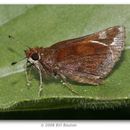Poanes zabulon is a "skipper" butterfly in the family
Hesperiidae. It has a thick, hairy body and hooked antennae, appearing to some more like a moth.
P. zabulon is small, with a wing span of 1 3/8 - 1 5/8 inches (3.5 - 4.2 cm). Males have black borders and no stigma, with the underside of their hindwings mostly yellow with a dark brown wingbase and outer margin. The upperside of females are purple-brown with pale yellow spots, with hindwing undersides that are brown and purple-gray with a white-edged costal margin. Favoring brushy openings near moist forests and streams,
P. zabulon ranges from Massachusetts west through southern Michigan to central Kansas; south to central Florida, southern Louisiana, and northeast Texas. Strays to New Mexico, South Dakota, and southern Quebec. A separate population ranges from central Mexico south to Panama. They are on the move from March to April and again in August to October in the south; and from May to July and again in August to September in the north. They are nectar feeders from plants such as the Japanese honeysuckle, red clover, everlasting pea, and selfheal, in addition to blackberry, purple vetch, common milkweed, buttonbush, joe-pye weed, and thistles. When at rest, most species of butterflies perch with both pairs of wings closed or with both pairs of wings open (horizontal). This includes many skippers especially the spread wing skippers (subfamily
Pyrginae). The other common position, the so called "jet plane position", is used mainly by the grass skippers (subfamily
Hesperiinae) In this position the hindwings are held lower than the forewings, which are held up at an angle but not vertical (Curtis 2012).

